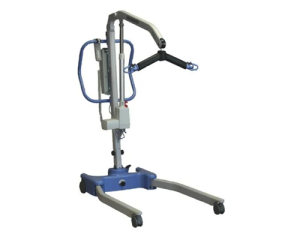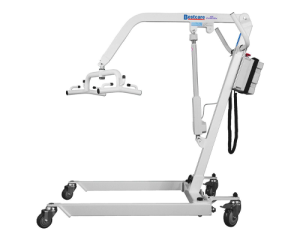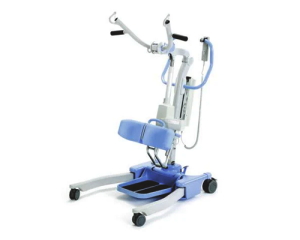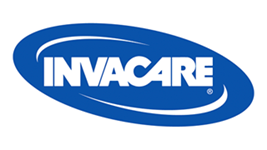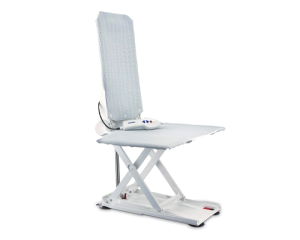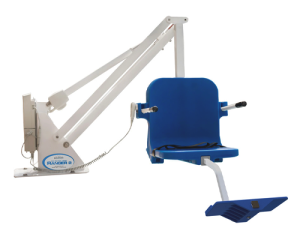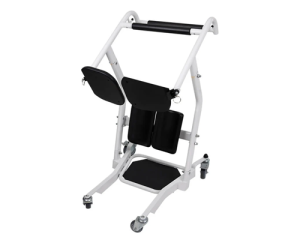- Price: $2,518, but may differ among dealers
- Type of lift: Powered Hoyer lift
- Weight capacity: 341 pounds (lbs)
- Battery: Rechargeable
- Financing and payment options: Depends on the dealer
Best Hoyer Lifts and Patient Lifts: A Complete Guide in 2025
Key Takeaways
- The best Hoyer lift or patient lift for you is the one that provides the right amount of help so you can perform tasks safely.
- In our review, patient lifts cost between $449–$4,595, depending on the type of lift.
- If you’re unsure which patient lift is right for you, a health care provider can evaluate your mobility and determine the most appropriate one.
Home is often where we feel the most comfortable and like ourselves. So it’s no surprise that in a Reviews Team survey of 600 people who use products to help with mobility, 71.5% said they prefer to age in their home. But some health conditions that cause mobility issues like chronic pain or neurological disorders like Parkinson’s disease can make it harder to move around the home safely. Fortunately, adults (and caregivers) can use mobility tools at home to help them move around easier.
Some adults might benefit from home patient liftsⓘ Most often used for home care or in nursing homes and hospitals, patient lifts are a mobility tool that allows people with limited mobility to be transferred safely, including from a bed to a chair, into the bath, and from sitting to standing. , like a Hoyer lift that provides total assistance, or other patient lifts that provide minimal to moderate assistance. We researched patient lifts and created this review to help you understand your options and find the best lift for your needs.

We also reviewed lifts designed to help people with stairs in their home. Check out our reviews on stair lifts or wheelchair lifts for more information.
Best Hoyer Lifts and Patient Lifts in 2025
- Hoyer Advance-E Power Lift: Best Electric Hoyer Lift
- Genesis 400 Hydraulic: Best Manual Hoyer Lift
- Journey Stand Aid Professional Quick-Ship Lift: Most Versatile Stand Assist
- Aquatec XL White Battery Powered Bathlift: Best Bath Lift
- Ranger 2 Pool Lift: Best Pool Lift
- Transport Stand Assist: Best Stand Assist for Home Use
Hoyer Advance-E Power Lift by Joerns Healthcare: Best Electric Hoyer Lift
Our expert take on the Hoyer Advance-E Power Lift
Our team likes the Hoyer Advance-E Power Lift because it’s designed for easy handling and storage. While Hoyer lifts are clunky devices, this model is more compact and easier for the lifter to control.
This lift is powered by a rechargeable battery and uses a simple remote control to raise and lower the lift’s boom and cradleⓘ A boom is the part of the Hoyer lift that looks like an arm reaching over the person being lifted. The cradle is located at the end of the boom and has hooks to which the sling can attach. . It comes with a power cord to recharge the battery when needed. Unlike some powered Hoyer lifts that use hand-held controls, the legs of this option are controlled using a foot pedal. Some people may find this a more convenient way to adjust the legs when preparing the lift.
One unique element we appreciate is its tapered (or angled) leg design, which “hugs” beds, recliners, and toilets so the lift can reach a person on bulky furniture. We also like how it can be folded when not used for storage or easy transport, whether moving it to another level of the home or placing it in the car. Since the Hoyer Advance-E Power Lift is made with lighter aluminum metal, it weighs relatively less than most other Hoyer lifts at about 69 pounds and is easier to lift. This can also help caregivers move it around a space more easily.
It has a large handle for easier steering and a footpad to help push the lift into motion. This is especially helpful if you’re moving it over carpeted floors, although it’s typically recommended to use lifts on solid floors as they move better that way.

This model has a two-year manufacturer warranty against material defects, and structural and mechanical parts are covered for five years. This does not include the battery or casters (wheels) since they can have wear and tear from everyday use, but they are covered for 90 days after delivery.
Our mobility expert’s take
Who may love it
- Aids and caregivers who need help transferring someone with total or near-total assistance for mobility
- People who need a home-friendly Hoyer lift with easy controls and steering
- Those seeking a portable Hoyer lift that can be stored when not in use
Who may want to avoid it
- People who need a higher weight limit than 341 pounds
- Those who need a more budget-friendly option
- People who are able to partially support their own weight and safely transfer with little to moderate assistance
Customer reviews on the Hoyer Advance-E Power Lift
The Hoyer Advance-E Power Lift has a good reputation across dealer sites, including 1800Wheelchair, where it received five out of five stars from eight reviews. Most people found this lift easy to use, and customer service was helpful if they had any issues.
“Good product, easy ordering, shipped promptly.”
— William A., verified buyer on 7/9/23
“In the beginning, I had trouble understanding how to use the holster and turn on the lift, but by calling the manufacturer, he was able to walk me through it. It is great and a big relief to my back.”
— Taylor A., caregiver and verified buyer on 4/11/23
Genesis 400 Hydraulic: Best Manual Hoyer Lift
Our expert take on the Genesis 400 Hydraulic lift
People who need a budget-friendly Hoyer lift may consider a manual lift, like the Genesis 400 Hydraulic. While it may not be as easy to use as a battery-powered lift, it’s still helpful for caregivers who need to transfer a person—but at a lower price.
Rather than using a remote to control the boom and cradle, you hand-pump a lever to raise the lift and turn a knob to lower it. To prepare the lift and position the legs, use the foot pedals by the lift’s base, similar to the Hoyer Advance-E Power Lift.
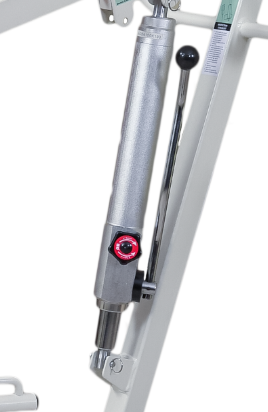
The Genesis 400 Hydraulic also competes with other manual lifts by offering a six-point cradle or six hooks to securely attach a sling. Our research showed that only some lifts offer this feature, so it’s a nice perk that offers added security for the user.
Our team likes this lift primarily because it can be upgraded from manual to battery operation any time after purchase. It has a slightly higher price than other manual lifts but is relatively low cost if the powered lifts don’t fit your budget. If you decide a powered lift is more appropriate, you can purchase the Electric Upgrade Kit for $983 (discounted to $786 through Spinlife). You must assemble this yourself unless you purchase white-glove delivery (delivery and setup) through a dealer. Purchasing and upgrading this lift over time can be a better option than financing a powered lift to avoid interest and lower overall costs.
The Genesis 400 Hydraulic lift is covered under a three-year warranty for the entire frame and cradle. You also get two-year coverage for the casters (wheels) and most electrical parts if you purchase the Electric Upgrade Kit. The hydraulic pump (and battery, if you upgrade) is covered for one year.
Our mobility expert’s take
Who may love it
- People who can operate a manual hydraulic system
- Those who feel more secure using a six-point cradle system
- Anyone who isn’t sure if an electric lift fits their budget or needs
Who may want to avoid it
- Caregivers who need additional help for safety
- People who are able to partially support their weight and safely transfer with minor to moderate assistance
- Those who want a manual lift and don’t plan on upgrading
Customer reviews on the Genesis 400 Hydraulic lift
The Genesis 400 Hydraulic lift has positive reviews across dealer sites. On Spinlife, it has 4.5 out of five stars with 40 reviews. This product has been on the market for many years, and reviewers have praised its quality over time.
“Very powerful and easy to use inside the house.”
— Jasser M., reviewer on 1/17/19
“One person can handle this lift. I can’t think of weaknesses at this time.”
— Debra W., caregiver and reviewer on 3/10/18
Journey Stand Aid Professional Quick-Ship Lift: Most Versatile Stand Assist
Our expert take on the Journey Stand Aid Professional Quick-Ship Lift
The Journey Stand Aid Professional Quick-Ship Lift is the most versatile stand-assist device we’ve seen in the industry. Although it’s more expensive compared to simpler stand-assist lifts without sling attachments, its design allows caregivers to help with a sit-to-stand transferⓘ A clinical term for when a caregiver helps someone go from sitting to standing on any surface for various body types or levels of mobility—as long as they can support some weight through their legs and show trunk control (or enough strength to prevent themselves from falling over).
We like how this lift’s sling attachments adjust between small, medium, and large sizes depending on the person’s height and position. You can also adjust the knee pads (with shin straps to secure legs in place) to the person’s height to ensure they receive the right support. A lot of other stand assists don’t offer as many adjustment points or body support systems.
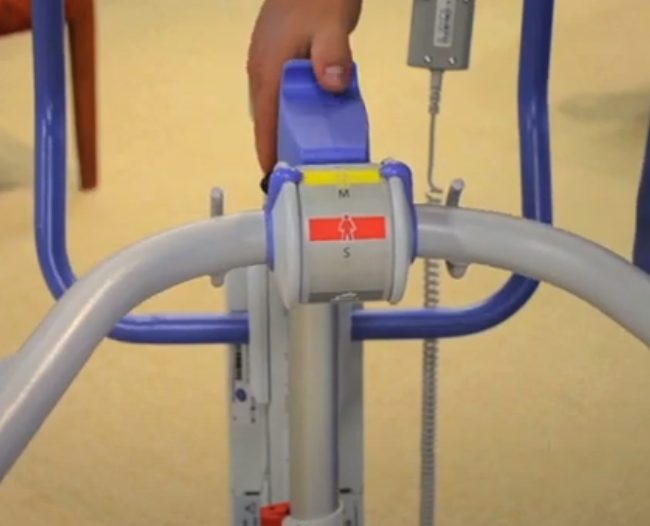
Similar to the Hoyer Advance-E Power Lift, this stand assist has adjustable tapered legs to better position the lift. It also has large handles and a foot push pad to make movement easier, especially when a person is on the lift or the wheels are rolling on carpeted floors.
A two-year manufacturer warranty covers the Journey Stand Aid Professional Quick-Ship Lift against defects on mechanical and electrical parts. The structural components are covered for five years after the delivery date.
Our mobility expert’s take
Who may love it
- Caregivers who need help when performing transfers
- People who can support a moderate amount of their weight but need to practice standing from support surfaces as part of their rehabilitation or heath maintenance plan
- Caregivers who care for more than one person and need one stand assist that can cater to many
Who may want to avoid it
- People who can perform a sit-to-stand transfer with little assistance may find this lift too helpful for rehabilitation
Customer reviews on the Journey Stand Aid Professional Quick-Ship Lift
The Journey Stand Aid Professional Quick-Ship Lift has many positive reviews across dealer sites. On Spinlife, it has 4.8 out of five stars with 23 reviews. All buyers recommended it, and many people found it easy to use.
“Easy to maneuver around in my house and very stable plus transportable.”
— Glen H., caregiver and reviewer on 11/26/19
“This lift is very strong and helps my 260-pound husband stand to transfer to his chair and bed.”
— Luann L., caregiver and reviewer on 11/13/19
Aquatec XL White Battery Powered Bathlift: Best Bath Lift
Our expert take on the Aquatec XL White Battery Powered Bathlift
The Aquatec XL White Battery Powered Bathlift caught our team’s attention because it’s lightweight but can support up to 375 pounds. The lift can fit in a 26-inch-wide tub, so it’s narrow enough to fit most tubs in the United States (a typical tub is at least 30 inches wide). Its tall back reclines, which allows the person in the tub to relax or adjust while a caregiver provides help. It’s also easy to fold away, carry, and store when not in use.

We like that this lift has a large, easy-to-use remote control that can be operated by either the person in the tub or a caregiver. The rechargeable battery is located in the remote and can be recharged, but it only lasts about four lifts at full weight capacity (or up to six with people who weigh less). This is low compared to other lifts that last more than 30 lifts, so you’ll need to monitor battery levels. A light on the remote will alert the user if there isn’t enough charge to lower and raise. If it turns on, the lift will be disabled for safety.
Unfortunately, this lift doesn’t come with a swivel seat or transfer board, so it’s not ideal for people who need at least moderate assistance getting in and out of the bath. Some dealers, like 1800Wheelchair, allow you to add these options at checkout.
The warranty offers three-year coverage for the major components and 18 months for the remote and batteries.
Our mobility expert’s take
Who may love it
- Caregivers who need help when positioning and bathing people in a tub
- People who can get into the lift and operate it to bathe safely and independently
- Households where not everyone uses the bath lift (because it can be easily stored)
Who may want to avoid it
- People who need more assistance to get in and out of the lift may want to add on a swivel seat or a transfer board
- Those who have a shower setup may find a shower chair more appropriate
Customer reviews on the Aquatec XL White Battery Powered Bathlift
The Aquatec XL White Battery Powered Bathlift has limited online reviews across dealer websites, but it has four out of five stars, with more than 60 reviews on Amazon. According to buyers, the bath lift helped them feel safer getting in and out of the tub. But we saw a few reviews that reported battery issues and limited customer support from Invacare.
“My mother loves it! It is easy to operate and the safety features are on point.”
— PA R., verified reviewer on 3/21/24
“Bought this to keep my 93 year old mother-in-law in her own home. Really made it easy for her to get in and out of the tub. No more fear of falling. Minimal set up. Easy to use. Easy to charge.”
— JB, verified reviewer on 5/29/23
Ranger 2 Pool Lift: Best Pool Lift
Our expert take on the Ranger 2 Pool Lift
We like the ADA-compliant Ranger 2 Pool Lift because it has a simple, secure, and customizable design. It has a relatively low weight limit at 350 pounds.
One feature that stood out to our team was its side-entry position. Unlike many other lifts on the market, the seat is parallel to the side of the pool. This takes up less space as you enter the pool and allows you to hold the wall as you exit the chair. The Ranger 2 also allows you to change the direction of the seat for more convenient access during installation. With other lifts, this type of customization may require additional tools or parts.
We also like how this lift has flippable arms and a footrest for a more secure ride. Flippable armrests allow a person to exit from the side of the seat if it’s more comfortable to do so. Plus, you get a seat belt for extra security.
The controls are easy to operate from the deck or the chair, so either a caregiver or the person in the lift can use them easily. It has a large two-button layout to raise and lower the lift, making it fairly simple, especially if you have dexterity issues (like from arthritis or certain neurological concerns, like a stroke).
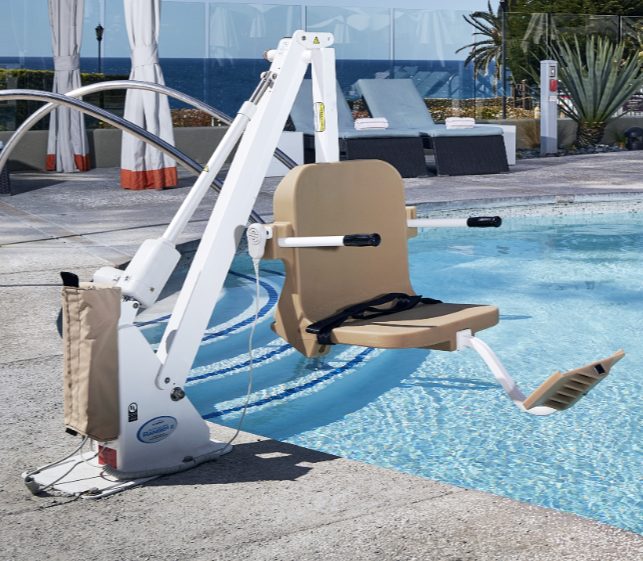
The Ranger 2 Pool Lift comes with a five-year limited warranty on structural components. Electrical parts have prorated coverage for five years—they’re completely covered for the first two years, but coverage decreases to 60% in the third year, 50% in the fourth, and 40% in the last.
Our mobility expert’s take
Who may love it
- People with mobility issues who are cleared to use the pool for recreational or rehabilitative purposes
- Caregivers who need an easy and safe way to transfer someone into a pool
- Those who want a sleek way to make their pool more accessible
Who may want to avoid it
- Those who need a lot of assistance to stay safe in the water should have medical clearance before purchasing this lift
- People who need a higher weight limit than 350 pounds
Customer reviews on the Ranger 2 Pool Lift
The Ranger 2 Pool Lift has limited online reviews across dealers, so it’s hard to gauge customer satisfaction. We found three mostly positive reviews on MedMart, where buyers love how their lift allows them to enjoy their pool.
“We love it! Now the whole family can use the pool. It’s very easy to use!”
— Darlene P., verified reviewer on 9/1/21
“Great device. Would recommend to anyone with a need.”
Carol G., verified reviewer on 5/25/21
Transport Stand Assist: Best Stand Assist for Home Use
Our expert take on the Transport Stand Assist
If you’re looking for a small-framed stand assist in your home, the Transport Stand Assist by Vive Health is a good option. Unlike the Journey Stand Aid Professional Quick-Ship Lift, this stand assist is not battery-powered and doesn’t use a sling, which lowers the cost by thousands of dollars. But this also means this type of lift is more appropriate for adults who only need minimum to moderate assistance standing up.
The Transport Stand Assist has a footpad, knee or shin pads, handles, and foldable seat pads. The legs can fit underneath many couches and chairs for easier positioning, although you’ll need about 5 inches of clearance. The person using the lift can hold onto the bars for security and stand up on the footpad (with assistance as needed).
Our team likes that this lift glides on wheels and is designed to move across different home surfaces. Once the user is on the lift, the caregiver can unfold the barstool-height seat pads as a place to rest. Then, they can transport the person to another room, similar to a wheelchair. Since this type of stand assist uses seat pads instead of a sling as the seat, it’s easy to stand for short periods of time and take a break, which can be useful during rehabilitation.
The one thing our team dislikes about the Transport Stand Assist is that it doesn’t fold away easily for storage. Instead, it must be disassembled, which isn’t convenient for quickly stowing in a car or closet. This lift weighs about 60 pounds, so if you plan to haul it up and down stairs, you may want to go with a more portable option. For reference, it takes up about the same floor space as a standard walker.
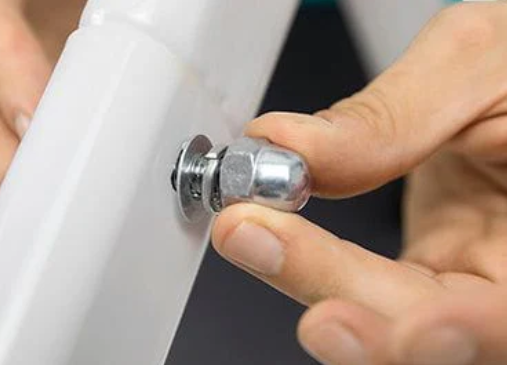
Our mobility expert’s take
Who may love it
- People who only need some assistance to stand up from a seated position and remain standing (with caregiver guidance)
- Those who need an affordable stand-assist option
- Anyone going through a rehabilitation program who needs to practice standing for short periods
Who may want to avoid it
- People who plan to stow or transport their stand assist
- Caregivers who need more adjustability on their lift to cater to more than one person
Customer reviews on the Transport Stand Assis
The Transport Stand Assist doesn’t have many reviews across dealers. Amazon has the most reviews (165), and ratings were four stars or above. People shared stories about its positive impact on their mobility or their ability to care for a loved one.
“My husband is twice my size in height and weight. I can get him up in this and transfer him in and out of a chair, bed, bedside commode, and bath chair. It’s amazing how it works.”
— Janet Q., verified buyer on 7/22/24
“This unit has been a life saver. My wife has recently been suffering from leg weakness. She cannot stand for more than 30 seconds before she starts to collapse. Several times she sags down to the floor and I can’t lift her up again. Several calls to the Fire Dept for assistance. This unit has worked wonderfully. I’m able to assist her when she stands, then I rotate the two clam shell like seats behind her and she is safe and secure. I can then wheel her to the bathroom, bedroom, etc. Great device and great price. Additional info. The base legs with the caster are fixed, however they are wide enough to fit around the base of a toilet. They are narrow enough to fit under a wheelchair.”
— Anonymous customer, verified buyer on 7/11/24
How we research home patient lifts
Our Reviews Team has dedicated more than 200 hours to evaluating mobility products like Hoyer lifts. We consulted at least six health care professionals, researched roughly 20 brands, and visited seven dealers to research products. We’ve also surveyed 1,200 recent buyers to understand their experiences shopping for a patient lift, including stair lifts and Hoyer lifts.
Lifts we test in person undergo an 18-step testing procedure to evaluate their different characteristics, including seat dimensions, remote functionality, user friendliness of features, and other aspects many shoppers consider, according to our survey results.
What are Hoyer lifts?
Hoyer lifts are patient lifts designed to move people from one location to another. These lifts are meant to transfer people who are highly dependent on caregiver assistance because they use a sling to do most of the lifting, which preserves caregiver effort and keeps both people safe. Ivetta Lassey, PT, DPT, founder and CEO of DrSensory, noted that Hoyer lifts are particularly useful for people who can’t bear weight on their legs or those who need someone to help them transfer.
A traditional Hoyer lift is a metal frame on wheels with hooks for attaching a sling. Caregivers prepare the Hoyer lift by placing the sling underneath the person and attaching it to the lift’s hooks. The caregiver controls the lift using manual pumps or electric power so the person is hoisted and moved wherever needed. Since its invention in the 1940s, the Hoyer lift has inspired other types of similar lifts, like Lifeway Mobility’s wall-to-wall and freestanding lift systems.
This type of lift is designed for people who need total or near-total assistance to move safely. If someone can move more by themselves, like getting out of bed or walking to a seat, this type of lift may offer too much help and hinder mobility improvements. Other patient lifts or assistive devices may be more appropriate, but your doctor will determine what’s best for your mobility.
What’s the difference between Hoyer lifts and other patient lifts?
A Hoyer lift is a patient lift, but not all patient lifts are Hoyer lifts. A traditional Hoyer lift has the framework to hoist a fully caregiver-dependent person in a sling, while other lifts may offer less assistance for other activities, like standing or going into a bath.
What are the different types of patient lifts?
Various patient lifts help people perform small and big tasks, from standing in place to traveling across the home. They can be temporary solutions during rehabilitation or long-term solutions for someone with a chronic medical condition. The right lift depends on your mobility level and tolerance, caregiver dependence, and activity goals.

According to our survey of 600 people who use a type of lift at home, 67.4% are primarily concerned about safety and security, and 44% are concerned about being able to complete daily tasks. About 97% also reported that their mobility products now make them feel safer in their home, and 96.3% said they feel more comfortable at home overall.
Hoyer lifts
A Hoyer lift is designed to provide total or near-total assistance to a caregiver when transferring someone from one place to another. They use a sling to hoist the person and can be manually or electronically controlled. Bariatric Hoyer lifts can lift people who weigh up to 850 pounds, and some compact Hoyer lift designs are more portable for home use.

Hoyer lift slings are typically purchased separately, although some Hoyer lifts come with a free sling included. Different types of slings are available for different body weights and sizes, and some are designed for bath or shower transfers.
Stand assist lifts
Stand assist lifts (also known as sit-to-stand lifts) help people who can support most of their weight transfer from sitting to standing. Similar to a Hoyer lift, many use a sling attached to a mechanical frame to hoist the person from a sitting to a standing position. These lifts are typically on wheels, so a caregiver can move the person around the room or house in the standing position.
Some stand-assist lifts are designed for people who can stand up with assistance but can’t remain standing for long periods of time. These lifts have built-in seats that allow the person to perch at bar stool height for a break and then stand again with less effort. These lifts are also on wheels, so a caregiver can easily move the person around a room or home without transferring to a wheelchair.

“Sit-to-stand lifts are particularly beneficial for individuals who have some ability to bear weight on their legs but require assistance due to weakness, limited range of motion, or balance issues. They are appropriate for patients who are undergoing rehabilitation or those with conditions like severe arthritis, Parkinson’s disease, or general age-related mobility challenges. Additionally, therapy personnel typically prefer to use this to improve upright standing tolerance for patients that are unable to tolerate standing positioning for enough time to complete a transfer or ambulate short distances.”
— Ivetta Lassey, PT, DPT, founder and CEO of DrSensory
Bath lifts
Bath lifts are mechanical seats that allow a person to safely enter the bathtub with less caregiver assistance or risk of falls. The waterproof design has a remote control (often connected to the seat) to lower or raise a person out of the bath. Many bath lifts have added accessories, like a transfer board or a swivel seat, to make it easier and safer for someone to enter or exit the bath.

According to the U.S. Centers for Medicare & Medicaid Services, bathtub lifts will likely be denied insurance coverage because they are considered a convenience item. See all covered durable medical equipment on the Durable Medical Equipment Reference List.
Pool lifts
If you have a swimming pool at home and are cleared to swim for recreation or as part of rehabilitation, a pool lift can help you safely transfer from a wheelchair to the water. The mechanical lift is permanently installed on the side of the pool and requires one person to operate it.
Ceiling lifts
Ceiling lifts are like permanent Hoyer lifts installed in someone’s home to help them transfer independently or with less caregiver effort. This lift uses a rail system, which is installed around the home’s ceiling and hooks onto a body support system or sling. The system lifts the person and moves them to another room or seat along the pathway. The ceiling lift can be operated without help depending on the person’s independence level, including their ability to get into the body support system and operate the controls.

“Ceiling lifts are ideal for individuals with severe mobility limitations who require frequent transfers or when space is limited, as they do not take up any floor space. They’re particularly appropriate for long-term care in the home and are often used for individuals with chronic conditions or disabilities that require full assistance for transfers and mobility.”
— Ivetta Lassey, PT, DPT, founder and CEO of DrSensory
How to use a patient lift safely
The first step to using a patient lift safely is ensuring the lift is appropriate for the person in it. A lift that doesn’t provide enough assistance to someone who needs a high level of support could cause a fall or injury. An occupational or physical therapist can determine what level of assistance a person needs before choosing a lift.
Some lifts are designed to provide moderate to maximum assistance and need a caregiver to help operate them, like Hoyer lifts. It’s important that the person operating the lift knows how to properly secure the person in a sling or support system to decrease the risk of injury. Although many lifts generally operate the same, hooks, slings, and wheel locks may operate slightly differently, so it’s important to read the user manual before using the lift with a person on it. “It’s also important to follow weight capacity guidelines, never exceeding the lift’s limit, as this can compromise safety,” Lassey said.
When operating a patient lift on behalf of the user, communication is key. “Talking with the patient throughout the process is essential to ensure they are comfortable and aware of what is happening. The lift should be operated slowly and carefully, avoiding sudden movements that could cause discomfort or injury,” Lassey said.
If someone is independent enough to use a lift on their own, like a ceiling lift, they should be trained to use it and practice with professional guidance. There may be important considerations for your specific condition to make it easier or more comfortable, like preparing the sling in a certain way or transferring in or out of the support system using a safe strategy.
How much do Hoyer Lifts cost?
The cost of a Hoyer lift can vary depending on the type you purchase, the brand, and if you purchase a new or used option. In Lassey’s experience, a manual Hoyer lift can cost $400–$1,000, an electric Hoyer lift can cost $1,000–$3,000, and a bariatric Hoyer lift can cost $2,000–$5,000. According to our team’s research, the cost can approach $5,000.
But there are options to lower the cost. “Many insurance companies, including Medicare, may cover Hoyer lifts under durable medical equipment (DME) if the lift is deemed medically necessary and there is proper documentation to support this fact, so it’s essential to check with your specific insurance provider for coverage details,” Lassey said. Medicaid, flexible spending accounts (FSAs), and health savings accounts (HSAs) often cover DME with a prescription or letter of medical necessity as well.
Refurbished Hoyer lifts are also an option. “These often cost 30%–50% less than new models,” said Lassey. “But you need to ensure that it has been properly inspected, serviced, and comes with a warranty for added peace of mind.” You can also consider renting the lift if you only need it temporarily, and some DME distributors have rent-to-buy programs where you can purchase the lift over a period of time.
The cost also varies depending on the type of lift you choose. According to our team’s research, stand-assist lifts can cost $400–$4,000, bath lifts can cost $200–$5,000, pool lifts can cost $3,000–$6,000, and ceiling lifts start at $1,500. Similar to Hoyer lifts, they should be covered by most insurance plans with a doctor’s prescription, and there are refurbished or rental options for those who want to cut costs.
Compare patient lifts, as of 2025
| Price (may differ among dealers) | $2,518 | $825 | $3,663 | $1,745 | $4,595 | $449 |
| Type of lift | Powered Hoyer lift | Manual Hoyer lift | Stand assist | Bath lift | Pool lift | Stand assist |
| Weight capacity (pounds) | 341 | 400 | 340 | 375 | 350 | 400 |
| Battery | Rechargeable | None (upgrade available for $700–$900) | Rechargeable | Rechargeable | Rechargeable | None |
Bottom line
If you’re looking for the best Hoyer lift or patient lift, make sure to talk to a health care professional (like a physical or occupational therapist) to find the right one for your mobility level.
According to our team’s research of patient lifts, the Hoyer Advance-E Power Lift and Genesis 400 Hydraulic are two of the best Hoyer lifts on the market. If you or someone you care for need less assistance, consider the stand assists and bath lifts in our review. And if you have a pool that can be used safely or as a part of your rehabilitation, consider the Ranger 2 Pool Lift.
Frequently asked questions
Medicare Part B may cover a patient lift if your doctor prescribes one for home use because it qualifies as durable medical equipment.
Hoyer lifts are only one type of patient lift, but there are alternative options designed to help transfer people and assist caregivers. It’s important to consider different types of lifts depending on the person’s mobility needs and desired outcome. For example, a stand assist can help someone bear weight through their legs for rehabilitation, while a bath lift is designed to help a person practice hygiene and self-care.
The first step is to discuss your mobility concerns with your doctor. Physical and occupational therapists can provide a mobility assessment and communicate with you, your caregiver (if applicable), and your doctor about choosing the best patient lifts or mobility assistance tools. Then, you can narrow down which models and features are most helpful.
Have questions about this review? Email us at reviewsteam@ncoa.org.
Sources
- NCOA. Mobility Survey. 600 respondents. Conducted using Pollfish. Launched August 2024.
- ADA Requirements: Accessible Pools Means of Entry and Exit. Americans with Disabilities Act. Feb. 28, 2020. Found on the internet at https://www.ada.gov/resources/accessible-pools-requirements


